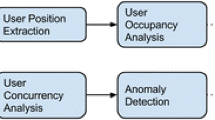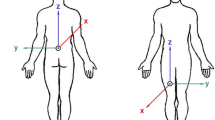Abstract
As people live longer, the increasing average age of the population places additional strains on our health and social services. There are widely recognised benefits to both the individual and society from supporting people to live independently for longer in their own homes. However, falls in particular have been found to be a leading cause of the elderly moving into care, and yet surprisingly preventative approaches are not in place; fall detection and rehabilitation are too late. In this paper we present FITsense, which is building a Smart Home environment to identify increased risk of falls for residents, and so allow timely interventions before falls occurs. An ambient sensor network, installed in the Smart Home, identifies low level events taking place which is analysed to generate a resident’s profile of activities of daily living (ADLs). These ADL profiles are compared to both the resident’s typical profile and to known “risky” profiles to allow evidence-driven intervention recommendations. Human activity recognition to identify ADLs from sensor data is a key challenge. Here we compare a windowing-based and a sequence-based event representation on four existing datasets. We find that windowing works well, giving consistent performance but may lack sufficient granularity for more complex multi-part activities.
Access this chapter
Tax calculation will be finalised at checkout
Purchases are for personal use only
Similar content being viewed by others
References
Population Division, United Nations Department of Economic and Social Affairs: World population ageing (2015)
NHS Improvement: The incidence and costs of inpatient falls in hospitals (2017)
Tian, Y., Thompson, J., Buck, D., Sonola, L.: Exploring the System-Wide Costs of Falls in Older People in Torbay, pp. 1–12. The King’s Fund, London (2013)
Turner, S., Kisser, R., Rogmans, W.: Falls among older adults in the EU-28 : key facts from the available statistics. Technical report, Swansea University, EuroSafe (2015)
Arfken, C.L., Lach, H.W., Birge, S.J., Miller, J.P.: The prevalence and correlates of fear of falling in elderly persons living in the community. Am. J. Public Health 84(4), 565–570 (1994)
Katz, S., Ford, A.B., Moskowitz, R.W., Jackson, B.A., Jaffe, M.W.: Studies of illness in the aged. the index of ADL: a standardized measure of biological and psychosocial function. J. Am. Med. Assoc. 185, 914–919 (1963)
Vestergaard, S., Patel, K.V., Bandinelli, S., Ferrucci, L., Guralnik, J.M.: Characteristics of 400-meter walk test performance and subsequent mortality in older adults. Rejuvenation Res. 12(3), 177–184 (2009)
Stone, E.E., Skubic, M.: Unobtrusive, continuous, in-home gait measurement using the Microsoft Kinect. IEEE Trans. Biomed. Eng. 60(10), 2925–2932 (2013)
Jiang, S., Zhang, B., Wei, D.: The elderly fall risk assessment and prediction based on gait analysis. In: 2011 IEEE 11th International Conference on Computer and Information Technology, pp. 176–180 (2011)
Montero-Odasso, M., et al.: Gait velocity as a single predictor of adverse events in healthy seniors aged 75 years and older. J. Gerontol. 60A, 1304–1309 (2005)
Rana, R., Austin, D., Jacobs, P.G., Karunanithi, M., Kaye, J.: Gait velocity estimation using time-interleaved between consecutive passive IR sensor activations. IEEE Sens. J. 16(16), 6351–6358 (2016)
Tapia, E.M., Intille, S.S., Larson, K.: Activity recognition in the home using simple and ubiquitous sensors. In: Ferscha, A., Mattern, F. (eds.) Pervasive 2004. LNCS, vol. 3001, pp. 158–175. Springer, Heidelberg (2004). https://doi.org/10.1007/978-3-540-24646-6_10
Suryadevara, N.K., Mukhopadhyay, S.C.: Wireless sensor network based home monitoring system for wellness determination of elderly. IEEE Sens. J. 12(6), 1965–1972 (2012)
Van Kasteren, T., Noulas, A., Englebienne, G., Kröse, B.: Accurate activity recognition in a home setting. In: Proceedings of the 10th International Conference on Ubiquitous Computing, pp. 1–9. ACM (2008)
Cook, D.J., Schmitter-Edgecombe, M.: Assessing the quality of activities in a smart environment. Methods Inf. Med. 48(5), 480 (2009)
Kim, E., Helal, S., Cook, D.: Human activity recognition and pattern discovery. IEEE Pervasive Comput. 9(1), 1–14 (2010)
Cook, D.J., Schmitter-edgecombe, M., Cook, D.J., Schmitter-edgecombe, M., Dawadi, P.: Analyzing activity behavior and movement in a naturalistic environment using smart home techniques. 19, 1882–1892 (2015)
Hall, M., Frank, E., Holmes, G., Pfahringer, B., Reutemann, P., Witten, I.H.: The WEKA data mining software: an update. SIGKDD Explor. 11(1), 10–18 (2009)
Acknowledgements
This work was part funded by The Scottish Funding Council via The Data Lab innovation centre. Thanks also to Matt Stevenson at Carbon Dynamic and Angus Watson at NHS Highland, Inverness for their support of the FITsense project.
Author information
Authors and Affiliations
Corresponding author
Editor information
Editors and Affiliations
Rights and permissions
Copyright information
© 2018 Springer Nature Switzerland AG
About this paper
Cite this paper
Massie, S., Forbes, G., Craw, S., Fraser, L., Hamilton, G. (2018). FITsense: Employing Multi-modal Sensors in Smart Homes to Predict Falls. In: Cox, M., Funk, P., Begum, S. (eds) Case-Based Reasoning Research and Development. ICCBR 2018. Lecture Notes in Computer Science(), vol 11156. Springer, Cham. https://doi.org/10.1007/978-3-030-01081-2_17
Download citation
DOI: https://doi.org/10.1007/978-3-030-01081-2_17
Published:
Publisher Name: Springer, Cham
Print ISBN: 978-3-030-01080-5
Online ISBN: 978-3-030-01081-2
eBook Packages: Computer ScienceComputer Science (R0)




